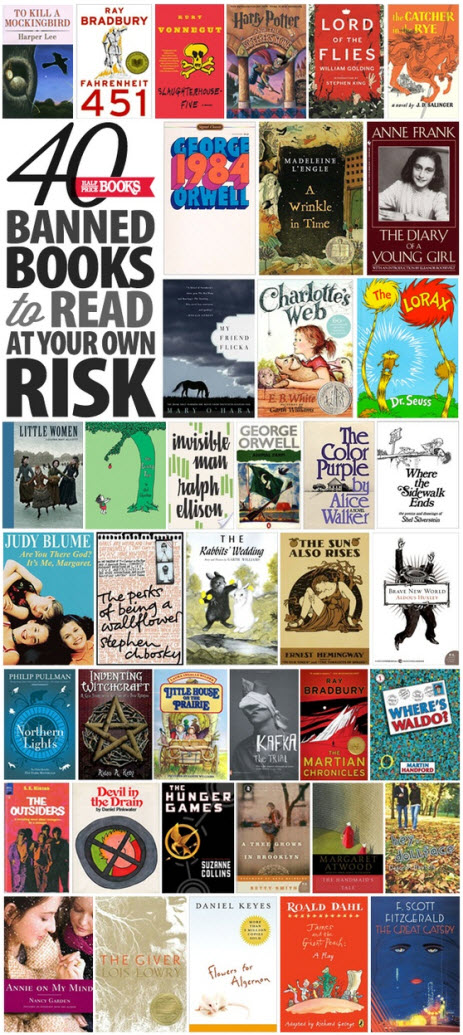Banned Books Week (Sept 30-Oct 6) is celebrating, for want of a better term, its 30th year!
 Banning books has a long and ignoble history going back into the mists of time. Possibly the oldest known ban was against 5th century BC Greek philosopher Anazagoras who made the mistake of suggesting that the sun is "white hot stone and that the moon reflected the sun's rays" - which caused him to be exiled from Athens and all his writings burned.
Banning books has a long and ignoble history going back into the mists of time. Possibly the oldest known ban was against 5th century BC Greek philosopher Anazagoras who made the mistake of suggesting that the sun is "white hot stone and that the moon reflected the sun's rays" - which caused him to be exiled from Athens and all his writings burned.
Of course, through much of history it wasn't just the writings that got burned but the writers themselves. Indeed, it wasn't even necessary to put pen to paper to find oneself atop a bonfire, or other equally nasty fate - a word, a deed, or even the mere suspicion of a thought could have been enough. So, I suppose we should be grateful that in the USA today we've evolved from burning people to merely attempting to ban their books.
 The history of book censorship in the USA began in 1873 when Anthony Comstock founded the New York Society for the Suppression of Vice. The target of the society's ire was primarily dime novels which the society believed enticed children to a life of crime and lust. Comstock died in 1915 and the society dwindled away until it was dissolved in 1950, after Comstock's successor retired.
The history of book censorship in the USA began in 1873 when Anthony Comstock founded the New York Society for the Suppression of Vice. The target of the society's ire was primarily dime novels which the society believed enticed children to a life of crime and lust. Comstock died in 1915 and the society dwindled away until it was dissolved in 1950, after Comstock's successor retired.
Book banning and challenging saw a resurgence in the early 1980s, in 1982 to be specific, at the start of Ronald Reagan's presidency - an event which appears to have emboldened some to strike back at a grass-roots level at the liberalization of the 1960s and '70s. Banned Books Week was launched that same year in response to the surge in the number of challenges to books in schools, bookstores and libraries.
Also in 1982, the Supreme Court ruled on the matter in Board of Education Island Trees v. Pico. By a 5-4 vote, the Court held that school officials cannot remove books from a school library simply because they find the ideas in the books objectionable - a win for then seventeen-year-old Steven Pico and his four fellow high schoolers aged fourteen to sixteen who challenged the school board's decision and took the case all the way to the Supreme Court. However, one of the five judges in favor of the ruling refused to opine on the First Amendment question; thus, on this all important issue, the judgement was split and therefore no precedent was set for future cases.
Banned Books Week was launched that same year in response to the surge in the number of challenges to books in schools, bookstores and libraries.
Also in 1982, the Supreme Court ruled on the matter in Board of Education Island Trees v. Pico. By a 5-4 vote, the Court held that school officials cannot remove books from a school library simply because they find the ideas in the books objectionable - a win for then seventeen-year-old Steven Pico and his four fellow high schoolers aged fourteen to sixteen who challenged the school board's decision and took the case all the way to the Supreme Court. However, one of the five judges in favor of the ruling refused to opine on the First Amendment question; thus, on this all important issue, the judgement was split and therefore no precedent was set for future cases.
 Since 1982, more than 11,300 books have been challenged (and keep in mind that it's believed that only a fraction of challenges are reported, and thus counted). The most frequent challenges being that the material is "sexually explicit" or contains "offensive language"; other frequent challenges are that the material is not age appropriate, has an occult theme, contains violence or promotes homosexuality.
Since 1982, more than 11,300 books have been challenged (and keep in mind that it's believed that only a fraction of challenges are reported, and thus counted). The most frequent challenges being that the material is "sexually explicit" or contains "offensive language"; other frequent challenges are that the material is not age appropriate, has an occult theme, contains violence or promotes homosexuality.
Visit bannedbooksweek.org for all you could want to know about Banned Books Week; ala.org for a list of the most frequently challenged books; and BookBrowse's Pinterest page for loads of quotes and images relating to banned books.
About the images
The image above to the left is of a memorial in Berlin on the site of the infamous Nazi book burning ceremony of May 10, 1933. The memorial by Micha Ullman consists of a glass plate set into the cobbles, giving a view of empty bookcases. Engraved is a quote from Heinrich Heine, "Where they burn books, they ultimately burn people".
The image to the right is from Half Price Books who polled 3000 readers for their favorite banned or challenged books. Click the image for a larger version or visit the Half Price Books blog.